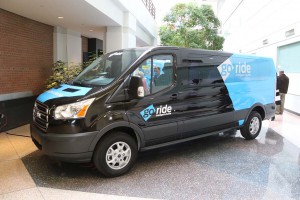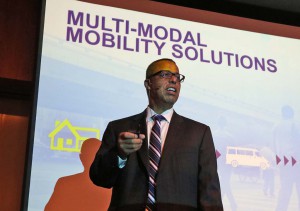When workers at the sprawling Ford Motor Co. campus in Dearborn, Michigan need to run from building to building for meetings they normally have to drive. But Ford is firing up a new program that should make it simpler and quicker to get around.
As part of the Dynamic Shuttle Project, the maker is fielding a fleet of 21 modified Ford Transit vans. They’re operating like a cross between a bus system and the increasingly popular Uber ride-share service, helping 100s of employees schedule rides through a smartphone app.
Last January, Ford announced it was studying 25 different alternative mobility projects. It has now narrowed that down to a handful that are going into operation in places as diverse as Dearborn, London, Mumbai and even The Gambia, one of the smallest and poorest countries in Africa.
“It’s about making mobility much more seamless,” said Erica Klampel, Ford’s manager of Global Mobility Solutions.
At the annual Consumer and Electronic Show in Las Vegas last January, CEO Mark Fields declared that Ford now sees itself as a “mobility company,” rather than simply an automotive manufacturer. That’s more than just a shift in semantics. It reflects the growing recognition that in urban areas around the world, many consumers are looking for alternative ways to get around and, in many cases, may not want to own automobiles.
(Ford investing $4.5 bil in new electrified vehicles by 2020. Click Here for details.)
That change in mindset is especially strong among Millennials, noted Ken Washington, Ford’s vice president of Research and Advanced Engineering. And the shift is likely to accelerate as more and more of the world’s population moves to urban centers – especially mega-cities like Beijing, Tokyo and Sao Paulo. There are 28 mega-cities today, with that expected to grow to 41 by 2030, according to Ford.
In the U.S., the urban population is expected to grow 38% between 2012 and 2030, noted Ford CEO Fields. And with traffic already making it difficult to move in many major cities, new transportation approaches are necessary.
The alternatives Ford is working on range from simple carsharing services to multi-model programs that can integrate a variety of different forms of transportation, including everything from buses and trains to bicycles and motorcycles.
In London, Ford has set up the GoDrive service. It’s similar to existing carsharing operations like ZipCar, but with a couple twists. One of the most significant is that a customer doesn’t have to return the vehicle to the original location. And Ford guarantees there will be parking when a motorist reaches their destination.
(Ford gets Siri-ous with new Sync software update. Click Here for the story.)
The Dynamic Shuttle Project — also known as GoRide — is meant to be more flexible than a traditional bus network, allowing users to travel door-to-door, though they may have to wait while the shuttle picks up and drops off other riders.
The key to making it efficient is the use of a dedicated data system that automatically decides which Transit van to use once a ride request is submitted by a smartphone app.
Currently, the service is limited to Ford employees traveling between 129 different locations in Dearborn. Eventually, the service could expand beyond the maker’s campus, however.
Another Ford project is a partnership with Riders for Health, a medical team serving The Gambia, a small and underserved country in Northwest Africa. The maker has not only provided some vehicles but also helps plan and track travel as doctors and nurses fan out across the country to reach patients in small villages. The system has helped boost the number of patients Riders can reach almost six-fold, according to Arthur Zysk, who oversees the effort for Ford.
Some analysts have questioned the logic of a carmaker like Ford supporting ride-sharing and multi-mobility programs that might lead some consumers to skip buying a car. But CEO Fields sees the strategy as essential to the future. The strategy, he says, is the “have one foot in today, one foot in tomorrow.”
There are still plenty of opportunities to keep growing car sales, especially in emerging markets, the chief executive contends. But Ford can’t afford to ignore the huge business opportunities highlighted by, among other things, the rapid growth of companies like Uber and ZipCar.
The new car business may generate about $1 trillion in business annually, but such alternatives could soon be worth even more, “and right now we’re not making a cent,” said Fields.
Besides, Ford is betting that car ownership will remain something of a lifestage phenomenon. So, even if a Millennial might initially opt for bikes, buses and trains, the thinking goes that they will eventually need a car as they start to raise a family.
“We see this as a very rational bridge to create loyalty” among users of alternative mobility services who will eventually want to buy Ford products, said Klampel.
(The autonomous technology field is getting more crowded. Click Here to see who the latest major player is.)



